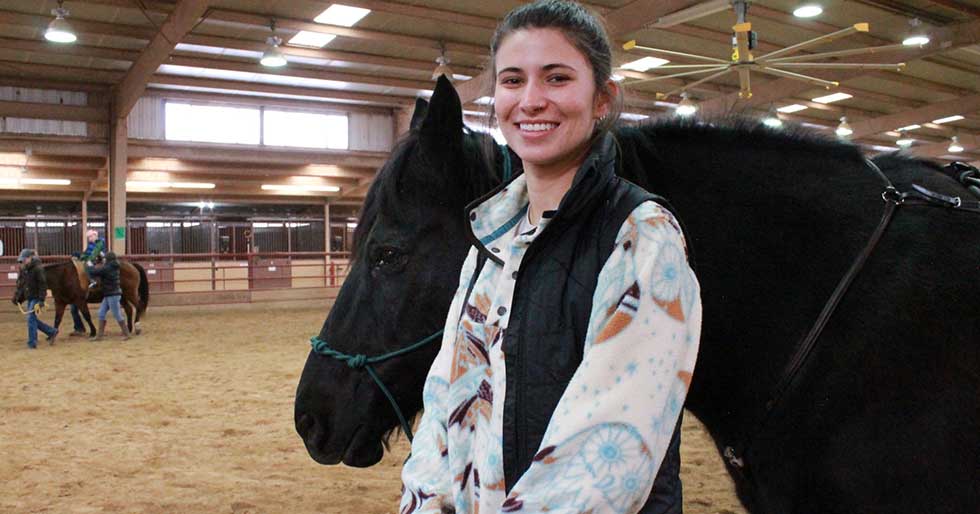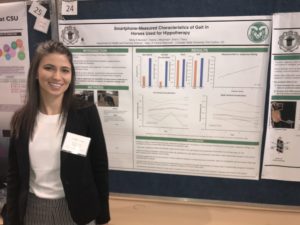
By Sarah Ross
In the last few decades, there have been many new advancements in treatment for children with disabilities, allowing them to explore a wide range of therapies for a variety of different physical, mental and emotional challenges. Hippotherapy, also known as horseback riding therapy, has been around for over a century in some form, but with the establishment of the American Hippotherapy Association in 1992, it has increased in popularity and become better known within the United States.
Therapists contend that equine therapies can address a variety of disabilities and ailments, from strengthening muscle groups and coordination due to the leg work needed to ride and guide a horse, to the mental discipline and emotional bonding that can help patients with mental illness, patients with addiction, or patients with behavioral or emotional concerns.
Colorado State University has partnered with My Heroes, a hippotherapy program out of Atlanta and Fort Collins, to help individual patients to meet their treatment goals through the use of therapy horses from the Temple Grandin Equine Center at the CSU Foothills Campus. The program also allows for CSU students to get involved with the therapies of local patients, giving them real-world experience in the field.
Molly Madden, a senior health and exercise science student at CSU and volunteer at My Heroes, joined the program her sophomore year and saw a need that has led to advancements in the field of hippotherapy and allowed her to complete her Honors Program undergraduate thesis with the therapy.
Avid equestrian
Before joining My Heroes, Madden was already an avid equestrian in her own right.
“I started riding horses competitively almost 10 years ago,” Madden said. “During this time, I rode in the Arabian breed circuit and was part of a 4H club. The 4H club was at a local level and a great experience overall. I focused on the Arabian circuit competitively and showed in the local, regional, national, and ‘international’ levels in Canada. I am lucky to have won seven national titles, and came in second five times, along with many other successful competitions at the regional level.”
When Madden came to college, she pursued a different path from her equestrian roots, instead choosing an education in the Department of Health and Exercise Science, but she still wanted to keep the equestrian interests that she had fostered alive.
“I began volunteering with My Heroes in January of 2017. I wanted to incorporate the knowledge I have gained from my classes at CSU with my knowledge of horses, which eventually led to my thesis,” said Madden.
Measuring gait and overall movement
With her equestrian background, Madden knew that each therapy horse is a little different, so there is often a need for the horses to be evaluated to make sure that they are a proper match for their rider. Hippotherapies use a rating scale based on the individual horse’s gait and overall movement pattern, which tries to rate the horse on how their gait affects how the rider feels during therapy. This scale was designed with the intent to capture the experience of the rider quantitatively, letting a rider or a therapist know approximately how each horse will feel while riding and letting them choose an appropriate therapy path based on the patient’s needs by matching them with a horse that fits their treatment criteria.
The scale allows therapists to feel like they could compare the horses, and if the patient moved to a new therapy program, they could continue to get the same level of care by standardizing horses between different therapy programs and different stables to one scale. However, these scale ratings are given without any real measurements being taken of the gait, allowing for the values to vary widely between stables or even between horses due to the subjective nature of their assignments. Without any quantitative data, it was hard to truly compare horses, making the scale hard to use and treatment paths harder to assign. Madden knew these scales were no longer working and tried to think of solutions.
“When I was volunteering at My Heroes, I realized the discrepancies between how the horses’ movements were rated versus how I perceived them as an equestrian,” said Madden. She also recognized that the biomechanics equipment needed to quantify the gaits and motion of these therapy horses were often inaccessible to many of these small programs, through monetary budget or availability. “One thing led to another, and Dr. [Brian] Tracy helped me narrow down my crazy research ideas into a tangible one, which became this thesis.”
Apple iPod as research tool

With the help of Brian Tracy, director of the Neuromuscular Function Laboratory in the Department of Health and Exercise Science, and Dr. Valerie Moorman from the Department of Clinical Sciences of the College of Veterinary Medicine and Biomedical Sciences, she devised an experiment to measure the actual movements of the therapy horses during walking and trotting, effectively quantifying the gaits of the therapy horses and showing that there was a cheap, viable solution that would allow for therapies to standardize the scale. Using an Apple iPod, Madden and her team used the accelerometers and gyroscope sensors built into the device to measure the gait movements in all three directions in real time to compare to the scale that the horses had originally been rated on.
“Our overall results showed a lack of correlation between the measured results and the subjective ratings for anterior/posterior movement and vertical acceleration from My Heroes,” Madden stated in her report, which she presented this April at the Celebrate Undergraduate Research and Creativity Symposium at CSU. “The lateral movement subjective rating was correlated loosely with the measured ratings we got from the iPod.”
Suggesting that the rating scale may not properly reflect the actual movement of the horse, she was able to establish that there are drawbacks to the gait rating system, while simultaneously proposing an easy, accessible and cost-effective solution. However, Madden thinks that her solution can be improved upon even further.
“With this information, we have shown that there is a more accurate way for these movements to be categorized,” Madden said.
Madden was able to prove that a smartphone, which 95% of United States citizens already own, or an iPod touch, which retails for around $200, can be used effectively to quantify the movement of therapy horses and more accurately assign them a scale for use by therapy professionals and their patients. Using devices that people already own or can purchase easily allows for these biomechanical programs to be more accessible for those who may not have been able to afford or procure the expensive software and devices needed previously. However, custom improvements can be made to the app software, Madden believes, that would make it even easier to measure the gait and give more accurate ratings to each horse.
“There must be improvements in any kind of applications on smartphones in order to make this kind of data more accessible for therapists to use,” said Madden. “In my opinion, the next step after this research is for the development of a smartphone application that would allow for this collection of data to be compiled and used easily by professionals. I am currently working on the manuscript for this research as well as creating a document for the My Heroes program with my interpretations of the data I collected, effectively categorizing the horses across the various planes of movement based on intensity.”
Madden graduates in May 2019, but she hopes to continue her education and expand her horizons outside of school.
Future plans
“After graduation, I am moving home to Tucson, Arizona, and will be working as a business analyst for a company called Cyan Funding,” said Madden. “I plan to take at least a year or two off from school so that I can be closer to my family, especially my grandparents, and also decide on what career path I’d specifically like to pursue. There are so many great options, I just really can’t decide!”
The Department of Health and Exercise Science is part of CSU’s College of Health and Human Sciences.
This article originally appeared on the Colorado State University website and is published here with permission. Find out more interesting articles in our section on Health & Education.
.
































